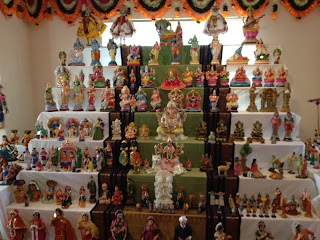Hari OM.
We started the class with a special Likhita Japa - ॐ विष्णवे नमः
We chanted OM and meditated for a few minutes.
We sang our opening prayers including the dhyana shloka that we had learned in the previous class describing Lord Vishnu.
Few kids had researched and shared their findings on: "Why the Sky is blue?" As blue is a color that represents infinity, no beginning or end, limit-less, we could very well understand why Vishnu, the one who pervades everywhere, is represented in blue color. That led us right to the discussions on the symbolism of Shri Vishnu.
AdisheSha
In the last class we had learned that Vishnu is depicted to be resting on a Thousand-headed snake/serpent, known as ananta or AdisheSha. Today we put on our inquisitive fifth-grader hat on, and asked what would resting on a snake imply? We discussed what a snake usually symbolizes in mythology, recollected few other symbols with a snake, and a few interesting facts about snakes: how they renew their skin, how they can be venomous, how they get charmed with music, etc.
In order to strike a victim, a cobra lifts up to a third of its upper body, fans out its rib bones to make a hood, hood/head facing outwards or away from its tail, and then strikes the victim with its fangs, acting like hypothermal needles, injecting neuro-toxins in the victim. If however the head is facing inwards and towards its tail, the cobra cannot strike the victim with its venom. Its predator, mongoose, hence attacks the cobra from behind! How interesting!
We now looked at the picture of Shri Vishnu carefully and noticed that the hoods/heads of AdisheSha are in-fact facing inwards or towards the tail/body! Harmless! We then made a connection with a human mind, when absorbed in objects around it, it is indeed capable of spreading its venom around, in the form of anger, jealousy, hatred, revenge, etc. On the other-hand, if it is turned inwards, it is harmless, and even more, it is capable of discovering the blissful, Shri Vishnu resting in its bosom!
No wonder in Bala Vihar we meditate, turning our mind inwards. If we sincerely strive eliminating all other thoughts, one fine day, in our heart, we are going to realize the blissful, glorious, Shri Vishnu!
We discussed that sheSha in sanskrit, means the rest, or, what is left over. Thus it can also symbolize that Vishnu always remains. He is not limited or bound by time, he is beyond time, hence the Lord of the past, present, and future.
Yoga nidra
We then talked about the significance of the restful posture in which Shri Vishnu is depicted. We discussed that in order to project a movie, a white, still screen in the background is required. Similarly, Lord Vishnu is being the still substratum in which the cosmic universal drama of creation/sustenance/dissolution is being played.
We narrated a story of a painter and a farmer. An artist is focussed, completely absorbed, in order to create master-pieces. The moral was one could be silently creating wonders, while being still!
First verse of shri viShNu sahasranAmam
The class learned the first verse of Vishnu sahasranamam, understanding what each name of the lord meant. We were thrilled to hear the melodious fifth graders chant the glorious names or Shri Vishnu, in chorus, in harmony!
viśvaṁ viṣṇurvaṣaṭkārō bhūtabhavyabhavatprabhuḥ |
bhūtakṛdbhūtabhṛdbhāvō bhūtātmā bhūtabhāvanaḥ || 1 ||
1: viśvaṁ: Universe or the Cause of Universe
2. viṣṇuḥ: All pervading, one who is everywhere
3: vaṣaṭkāraḥ: One who controls and directs, For whom offerings are sacrificed in yajnas
4: bhūta-bhavya-bhavat-prabhuḥ: The Master of all things past, future, and present
5: bhūta-krit: The creator of all beings
6 : bhūta-bhṛt: The supporter of all beings
7: bhāvaḥ: Pure Existence, He who exists always, independent of anything else
8: bhūtātmā: The soul of all beings
9: bhūta-bhāvanaḥ: One who nourishes and nurtures all beings
Parents, please encourage your children to chant the shlokas they have learned when the family prays at home or at temples. Ask them what each name of the lord signifies in the first verse, you will be in for a pleasant surprise.
Well, Gita chanting was a breeze, after chanting SVS. We have learned to chant verses 1 and 2 of chapter 13, so far.
We were running late for the assembly at the auditorium, amidst all the fun and excitement we were having in our class. With concluding prayers, we dispersed, eagerly awaiting to reconvene on Dec 9th.
namaste.
Section 1 Teachers







